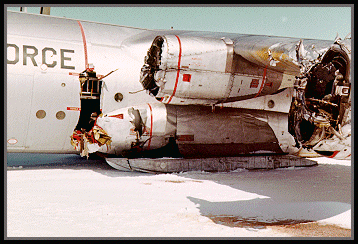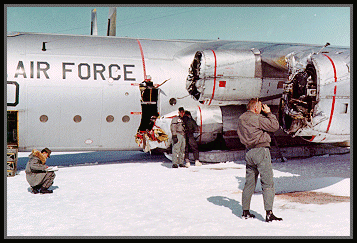It was the 27th of May, 1969, and the day began as usual for the Firebird crews on rotation to Sondrestrom AB, Greenland. Get out of the "sack" early, hit the communal restroom to shower and shave, pull on the flight suit, grab a little breakfast and a few cups of coffee, avoid the reconstituted white milk, flight plan, and be off the ground by around 0800 GMT. Following such tradition, the crew of 57-490, Tom Lewin, Don Miller, Harold Sacane, Bruce Huff, and Billy Hales departed Sondrestrom at 0810, on this date, enroute to DYE III on a routine petroleum resupply mission. The weather was good, with a high thin scattered layer of clouds, and fifteen miles visibility with winds 230 degrees at ten knots. The crew landed at DYE 3, off-loaded 23,000 pounds of diesel fuel, and departed the site without having to make the numerous takeoff attempts that were often required. |

Photo courtesy of Ed Holley | It was a good day to be "working" the Ice Cap. The "D Model" appeared to be performing well with no abnormal engine indications on the gauges. However, as 490 was leveled off and began to accelerate to cruise speed, at around 200 knots, three loud explosions were heard. The Hercules experienced an immediate rapid decompression, and severe vibrations began to affect flight. In fact, the aircraft became so uncontrollable that it required the efforts of both Tom Lewin and Don Miller to keep the "ski-bird" in the sky. The airspeed fell off rapidly, and a descent of 1,500 feet per minute was required to maintain 160 KIAS even though full climb power had been applied to the number three and number four engines. Full right rudder, full right rudder trim, and fifteen to twenty degrees of bank to the right were required to keep the aircraft from turning left. The Fire Emergency Control Handles were pulled when the number one and number two engines began to exceed published operating limitations. | |
| As soon as the aircraft was under control, the engineer, Bruce Huff, began a damage survey and reported that the number one and number two propellers had separated from their engines and that the number one propeller was embedded in the leading edge of the wing between the number one and number two engines. In addition, the number two propeller had slashed a hole approximately two and one-half by six feet in the left side of the fuselage at the propeller plane and had struck the left main ski. Unknown to the crew, the force of the propeller striking the ski separated the left main gear drive mechanism. | 
Photo courtesy of Ed Holley | |
| A right turn was attempted to return to the landing area at DYE III. This turn was soon aborted due to an extremely slow rate of turn, low altitude, and imminent open snow landing. After it was determined that continued flight was impossible, "the before landing checklist" was completed, and the aircraft commander and flight engineer confirmed that all landing gear and skis indicated "down." The crew leveled the wings in preparation for landing on an unprepared, opportune area. Fortunately, the open snow conditions were excellent, the snow was firm, drifts were at a minimum, and the weather continued to be good. | |
Initial contact with the snow was in a wings level attitude on an easterly heading. The touchdown was smooth, and excellent directional control was maintained for the first 2,500 feet of the 3,100 foot landing slide. At this point, the damaged left main gear collapsed, the left wing dropped abruptly, and the plane began to veer to the left turning a full ninety degrees before stopping. The remaining "Fire Emergency Control Handles" were pulled. Neither the left wing tip or left pylon tank contacted the snow and the crew was able to exit through the crew entrance door uninjured. | |
This is an example of the proficiency maintained by Firebird crew members in a very hostile environment. As stated in the C-130D flight manuals, flying the "D" model on the Greenland Ice Cap is deemed to be a calculated risk. Through extensive training, professionalism, and experience, this risk was reduced to a minimum by the 17th TCS/TAS Firebirds. | 
Photo courtesy of Ed Holley |